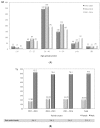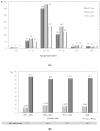Cryptococcosis in Colombia: Compilation and Analysis of Data from Laboratory-Based Surveillance
- PMID: 29494502
- PMCID: PMC5872335
- DOI: 10.3390/jof4010032
Cryptococcosis in Colombia: Compilation and Analysis of Data from Laboratory-Based Surveillance
Abstract
The passive and voluntary surveillance of cryptococcosis in Colombia since 1997 has seen an increasing participating rate, revealing its importance to both in immunosuppressed and immunocompetent people. The present work details the national data gathered in 1997-2016, through a retrospective analysis of the information collected in the survey. From a total of 1974 cases reported, an overall incidence of 0.23 cases per 100,000 people was found. This incidence rose to 1.1 cases per 1000 people in the Acquired Immunodeficiency Syndrome (AIDS) population. Cryptococcosis was most common in male young adults (26-40 years), with a male:female ratio of 3.9:1 in the general population and 5.4:1 in Human Immunodeficiency Virus (HIV) patients. Culture was the most common form of diagnosis in 96.3% of cases, recovering C. neoformans species in 87.5% and C. gattii in 3.1% of samples. VNI was the most prevalent (96.1%) molecular type, while VGII predominated in C. gattii isolates (54.3%). Early mortality was reported as the outcome in 47.5% of patients. Cryptococcosis remains an important opportunistic disease in Colombia and is gaining status as a primary pathogen in apparently immunocompetent patients. Our findings show the importance of including cryptococcosis as a notifiable disease, which will allow for improving opportune diagnosis and treatment, resulting in better patient outcomes.
Keywords: Colombia; cryptococcosis; epidemiology.
Conflict of interest statement
The authors declare no conflict of interest.
Figures



Similar articles
-
Cryptococcosis in Atlántico, Colombia: an approximation of the prevalence of this mycosis and the distribution of the etiological agent in the environment.Rev Soc Bras Med Trop. 2015 Sep-Oct;48(5):580-6. doi: 10.1590/0037-8682-0178-2015. Rev Soc Bras Med Trop. 2015. PMID: 26516968
-
Cryptococcosis in Colombia: results of the national surveillance program for the years 2006-2010.Biomedica. 2012 Sep;32(3):386-98. doi: 10.1590/S0120-41572012000300009. Biomedica. 2012. PMID: 23715187
-
Fatal Cryptococcus gattii genotype VGI infection in an HIV-positive patient in Barranquilla, Colombia.Rev Inst Med Trop Sao Paulo. 2017 Jun 1;59:e34. doi: 10.1590/S1678-9946201759034. Rev Inst Med Trop Sao Paulo. 2017. PMID: 28591262 Free PMC article.
-
[Cryptococcosis caused by Cryptococcus neoformans var. Gattii. A case associated with acquired immunodeficiency syndrome (AIDS) in Kinshasa, Zaire].Med Trop (Mars). 1992 Oct-Dec;52(4):435-8. Med Trop (Mars). 1992. PMID: 1494313 Review. French.
-
Cryptococcosis in the Amazon: A current overview and future perspectives.Acta Trop. 2019 Sep;197:105023. doi: 10.1016/j.actatropica.2019.05.014. Epub 2019 Jun 8. Acta Trop. 2019. PMID: 31181189 Review.
Cited by
-
Clonal Dispersal of Cryptococcus gattii VGII in an Endemic Region of Cryptococcosis in Colombia.J Fungi (Basel). 2019 Apr 15;5(2):32. doi: 10.3390/jof5020032. J Fungi (Basel). 2019. PMID: 30991682 Free PMC article.
-
Reduced Susceptibility to Azoles in Cryptococcus gattii Correlates with the Substitution R258L in a Substrate Recognition Site of the Lanosterol 14-α-Demethylase.Microbiol Spectr. 2023 Aug 17;11(4):e0140323. doi: 10.1128/spectrum.01403-23. Epub 2023 Jun 21. Microbiol Spectr. 2023. PMID: 37341584 Free PMC article.
-
Autoantibodies Neutralizing GM-CSF in HIV-Negative Colombian Patients Infected with Cryptococcus gattii and C. neoformans.J Clin Immunol. 2024 Jul 15;44(7):163. doi: 10.1007/s10875-024-01757-y. J Clin Immunol. 2024. PMID: 39008214 Free PMC article.
-
Microbiological, Epidemiological, and Clinical Characteristics of Patients With Cryptococcal Meningitis at a Tertiary Hospital in China: A 6-Year Retrospective Analysis.Front Microbiol. 2020 Jul 29;11:1837. doi: 10.3389/fmicb.2020.01837. eCollection 2020. Front Microbiol. 2020. PMID: 32849436 Free PMC article.
-
Cryptococcosis in Southern China: Insights from a Six-Year Retrospective Study in Eastern Guangdong.Infect Drug Resist. 2023 Jul 6;16:4409-4419. doi: 10.2147/IDR.S417968. eCollection 2023. Infect Drug Resist. 2023. PMID: 37435235 Free PMC article.
References
-
- Kwon-Chung K.J., Bennett J.E., Wickes B.L., Meyer W., Cuomo C.A., Wollenburg K.R., Bicanic T.A., Castañeda E., Chang Y.C., Chen J., et al. The Case for Adopting the “Species Complex” Nomenclature for the Etiologic Agents of Cryptococcosis. mSphere. 2017;11 doi: 10.1128/mSphere.00357-16. - DOI - PMC - PubMed
-
- Aminnejad M., Cogliati M., Duan S., Arabatzis M., Tintelnot K., Castañeda E., Lazéra M., Velegraki A., Ellis D., Sorrell T.C., et al. Identification and Characterization of VNI/VNII and Novel VNII/VNIV Hybrids and Impact of Hybridization on Virulence and Antifungal Susceptibility Within the, C. neoformans/C. gattii Species Complex. PLoS ONE. 2016;20:e0163955. doi: 10.1371/journal.pone.0163955. - DOI - PMC - PubMed
-
- Lizarazo J., Linares M., De Bedout C., Restrepo A., Agudelo C.I., Castañeda E., Grupo Colombiano para el Estudio de la Criptococosis Estudio clínico y epidemiológico de la criptococosis en Colombia: Resultado de nueve años de la encuesta nacional, 1997–2005. Biomédica. 2007;27:94–109. doi: 10.7705/biomedica.v27i1.236. - DOI - PubMed
-
- Escandón P., De Bedout C., Lizarazo J., Agudelo C.I., Tobón A., Bello S., Restrepo A., Castañeda E., Grupo Colombiano para el Estudio de la Criptococosis Cryptococosis in Colombia: Results of the national surveillance program for the years 2006–2010. Biomédica. 2012;32:386–398. doi: 10.1590/S0120-41572012000300009. - DOI - PubMed
LinkOut - more resources
Full Text Sources
Other Literature Sources

